#hügelkulture
Text
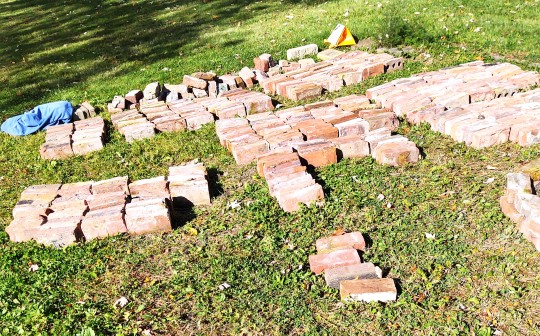



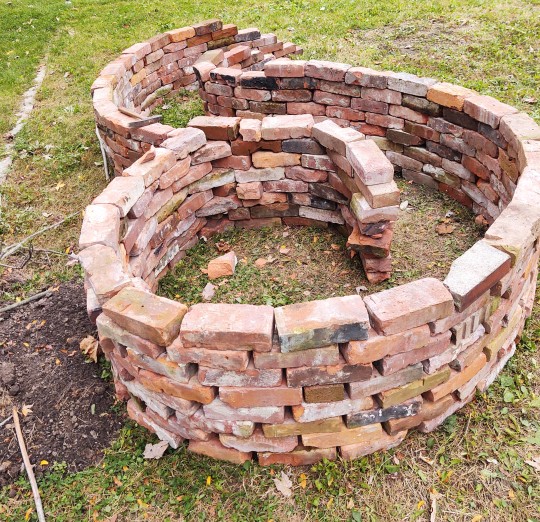


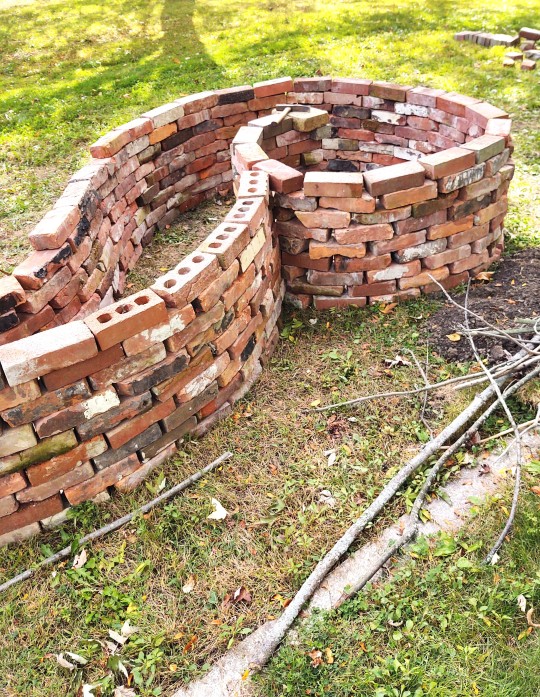
What to do with a ton of bricks.... Roughing in a hügelkultur spiral for next year's herb garden.
2 notes
·
View notes
Text
Hügelkultur - Sheetmulching Raised to New Heights
In my last post I discussed mulching as an effective way to help the water retention of your soil, while providing lots of nutrients over an extended time. Today I want to keep raising this technique to new levels, quite literally, in the form of Hügelkultur. Hügel means Hill in German (and I bet you can guess Kultur!), so this gardening method is often called hill or mound beds in English. Essentially they are advanced forms of lasagna beds, which also includes thick logs and other large-scale organic debris, and can rise up to shoulder high above ground level.

image source
Multiple Benefits of a Hügel Bed
Just as in the case of sheetmulching, the ground is covered with various layers of compostable materials. Unlike with simple sheetmulching, the logs and branches inside a Hügel will take several years to decompose, offering your plants many seasons of nutrients. Since the bulk of the mound is made up of wood, the decomposing material will become more and more porous, which can soak up more and more water. Due to the constant decomposition inside the bed, and the elevated planting area above the level of ground frost, the Hügel is also likely to extend your growing season. This is especially true if you build it in a horseshoe form, opening towards the South, creating an effective suntrap. The elevated planting beds also come in handy for gardening work you don't have to bend down for.

image source
Building Your Hügel-culture
A Hügelkulture can be built from the ground up, or you may dig a trench underneath if you're counting on plenty of water. The rule of thumb is always to put the material that takes the longest to decompose on the bottom, and build your way up from there. Recently cut logs, heartwood, or hardwood go way down below, followed by wood that is already rotting away happily. On top of the thicker logs you place layers of thinner branches, twigs, woodchips, then continue with straw, leaves, compost, and finally a good layer of fertile soil that you can plant into right away. Around the leaves and straw you may also include a layer of manure, cardboard, lawn clippings, kitchen compost, or whatever organic wastes you may have lying around. Just make sure they are well covered. And don't forget to water each layer to give your Hügel a good head start.
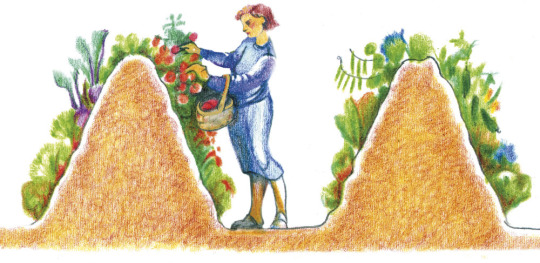
image source
Is All The Extra Work Really Worth It?
Granted, compared to a regular lasagna bed, a Hügelkultur involves a lot more work: Logs, branches, and sticks need to be cut and moved into place, then covered in several layers, which due to its hill shape will require a lot more material, while at the same time the benefits of a Hügel are pretty much the same as in sheetmulching: water retention and long term release of nutrients. Still, I would say the difference between the two is immense, since the Hügel does all that much better, and over longer time periods. So if you have the material available - and what else would you be doing with so much rotting wood? - I would say it's definitely worth the effort.

image source
Sources: 1, 2, 3, 4, 5, 6
20 notes
·
View notes
Text
Me: Finally home. I'll just make a cup of tea, sit by the fire, and write that Frankie fic.
Also me: Oh I'm getting a trailer full of firewood yeah sure I'll empty that and hey it's not raining any longer so I'll just get started on that Hügelkultur hey look whaddya know I built the whole thing!
Me: 😵😵😵
#this also means I don't have to build the hügelkultur tomorrow so...#FINALLY FREE AFTERNOON AND EVENING
8 notes
·
View notes
Text
just realized “I’ve written a prophecy” is hilarious when talking about farmer Joel because the prophet Joel tells a story of redemption and judgment day and purification and restoration and bounty and fruitfulness and hordes of armies that destroy and consume hundreds of times over and the wrath of a god who is vengeful and awesome in that old testament kinda way
in the context of this story, Joel absolutely refuses the call for several years even though literally everything is like. PAY ATTENTION DUDE PLEASE
if I end up calling this fic ‘the book of joel’ literally express ship a fist to my jaw
#I didn’t reject the church for this#actually I kinda did#but THATS BESIDE THE POINT#scardinata#there’s just something so 🤌 about the Refusal of the Call#and I haven’t purposefully used the monomyth/hero’s journey for story writing since high school#even though STC is essentially THJ#but I truly appreciate how impactful it is on so many other pieces of media#I’d say TLOU included#it’s cyclical and it’s poetic the way we see Joel go from whole to empty to broken to healed again#it’s not redemption it’s a circle#both can be valuable#but a circle doesn’t resolve cleanly which is why I think ppl have been resistant to TLOU’s canon#sometimes you just have to let a circle be a circle and you can’t fault it for having equal ups and downs#but also I’m very excited to rant about hügelkultur with y’all
2 notes
·
View notes
Text
Stop idolizing the grind and start idolizing Hügelkultur

92K notes
·
View notes
Note
For the record that person who mentioned "shoveling up into a mound" may have been referring to hügelkultur, it's a German style of gardening that utilitizes the sides of the mounds for growing space and is a bit more structurally stable than a simple mound of compost. Still not sure if that would help re: knees and ankles, but I just thought I'd put in my two cents
Hugelkultur tends to create long mounds, not the steep-sided structures I want, and also wouldn't work at the angle I'm building (directly down the sides of a very steep hill with high rainfall). I'm gonna do stairstep-shaped raised beds with sides.
I do plan on using hugelkultur mounds in the larger area of my yard to build gardens that can properly manage the water flow because right now it's just a wild zone of periodic mud and dust out there depending on the weather, but it'll be a few years before I can afford to get the big trees cut down that I want to use for it (they're mostly dead and if I don't get then cut down they will eventually fall on my house). But these beds are for higher maintenance vegetables and in a fairly limited and uncooperatively-shaped space so I want them high up and reachable without bending over or climbing anything. I've decided to build them out of sleepers (for framing) with tin sides, which seems to be the cheapest and most easy-to-assemble option. In a decade or so I might be able to put together something better but I have too many house maintenance tasks to pay for to be fancy right now.
37 notes
·
View notes
Text

A Hügelkultur raised bed is a centuries-old, traditional way of building a garden bed from rotten logs and plant debris. These mound shapes are created by heaping up woody material (that's ideally already partially rotten) topped with compost and soil.
477 notes
·
View notes
Text
my community elders told me not to give into despair, so im gonna get better about sharing good things.
interest in native / wildlife friendly gardening is at an all time high. Preserving traditional forms of gardening like three sisters and hügelkultur are becoming more popular too! i'm personally trying out three sisters this year.
7 notes
·
View notes
Text
Good day everyone :)
This week's garden update~
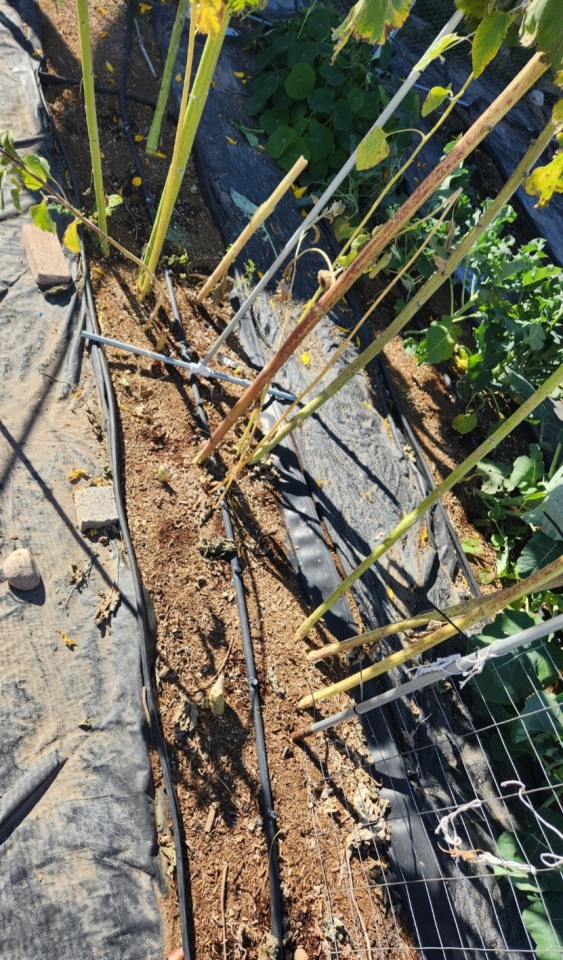
The beans and pumpkin that grew with the sunflowers are gone now and I've begun thinning out the sunflowers as the seeds get selected by birds.
I like to leave the smaller heads for the smaller native birds of the area. The heads i save, I've been setting into a drying rack where no birds can get to them.
The stalks I've been discarding the leaves in our cities green barrel (compost) program and I'm saving the stalks to either burn, or to chunk up and try a Hügelkultur grow bed. Not sure 100% what will eb grown in it, might be flowers or herbs, maybe strawberries.

This is currently the biggest sunflower yet! That pole is about 6ft off ground. I'll definatly need a ladder when it's time to take a few of the heads.
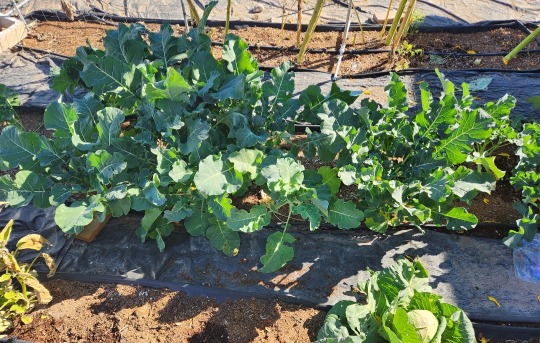
The broccoli row, there's some little florets now on most the plants! :D
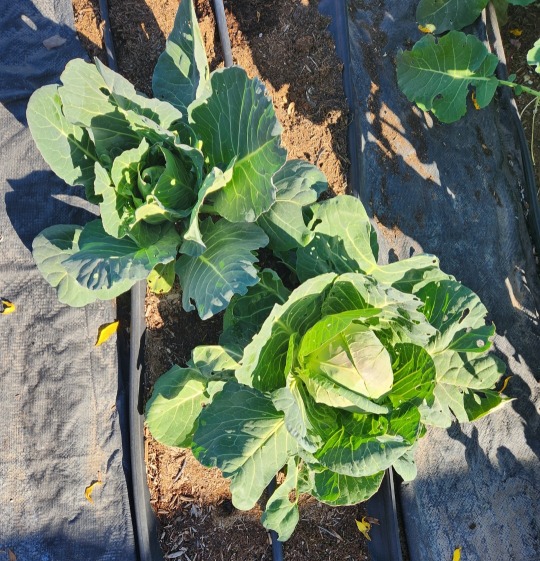
Cabbages, all four are similarly headed now.
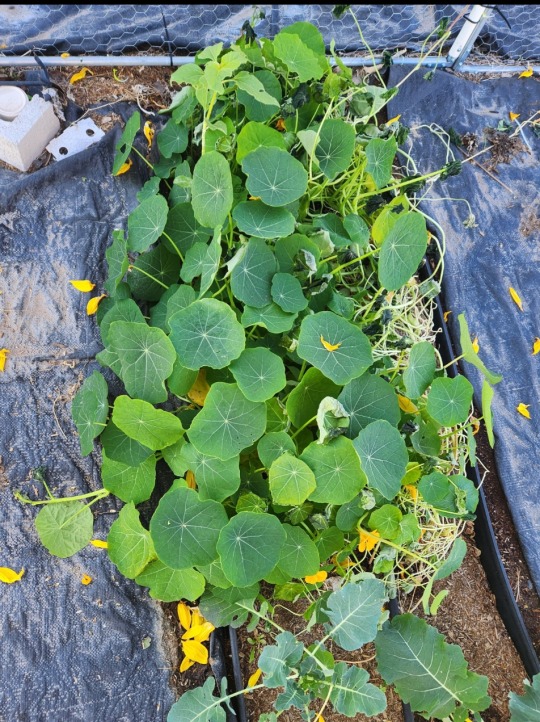
The nasturtium, which i need to go through and clean up a bit. The cold did get one side of em pretty sharply.
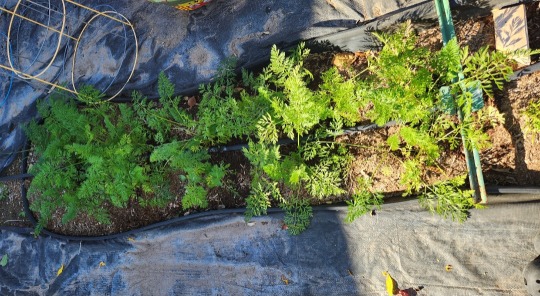
The carrots.
This is the batch I used the cornstarch planting method. So far, while they lined up real nice I feel like they aren't growing as well as i hoped. Now weather that's the seed, the planting spot or the season/weather I'm not entirely sure. I think I'll do a summer grow as well, just to test it out again.
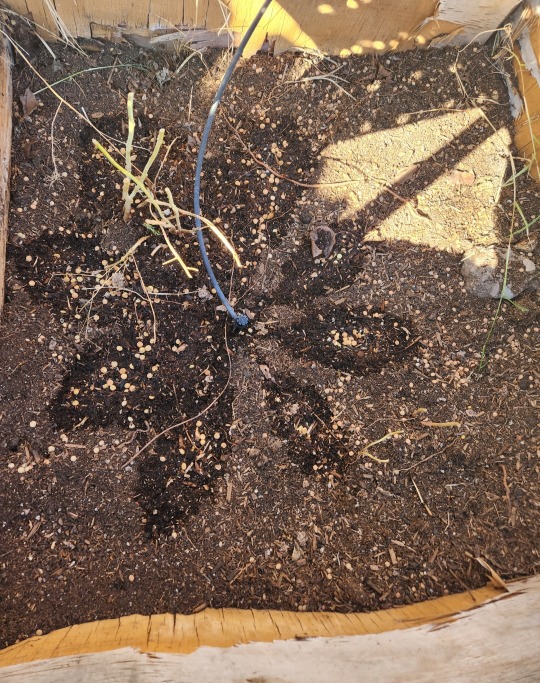
The back 'l" bed, ive direct seeded some lentils with the asparagus. I intend to grow the lentils then till them back in to the soil. We were going to dump this bed, but it seems we like it still so we'll likely be doctoring it up for a few more seasons.
Well thats it for now :)
🌱🌻Happy Homesteading and Gardening 🌻🌱
1 18 2024
#homesteading#self sufficient living#thestudentfarmer#studentfarmer#self sufficiency#food#garden#gardening#low waste#chickens#right to grow food#urban homesteading#urban gardening#urban farming#urban biodiversity#grow what you can#learning skills#going green as can be#cabbage#grow cabbage#sunflowers#live with nature#urban green spaces#urban growth#green space#carrots#grow carrots#edible landscaping#edible yards
7 notes
·
View notes
Text

Art Summary 2023~
And I still need to upload some things but ah, it be like that.
Another rather good year of art, branching out into other things I love as well as rekindling some love for other things, be it subjects, techniques or mixes. I am moving towards a shift I think, I have some ideas~
I also have big plans for the next year and some battleplans I am currently working on both for the stuff I wanna get to in general as well as for the downtimes I might experience. I took note this year, as I would declare it the first were I am actually doing okay and better with each day despite the shit-show that was 2019-2022. I am also starting to see the memory issues of that timeframe and the fact that a lot of stuff just got yeeted from my brain unless I put effort in to recall and have notes. Certain parts will remain harder for a while I assume, but this year around I managed them better, prepared better.
But yeh, overall, I found peace again this year and with that came a new creative wave, I started knitting alongside embroidery, I collected some tools and stuff to incorporate craftings into my works, I got that woodburning tools that is giving me bedroom eyes... and I am eying a big loom on amazon while planning out my gardening in a separate calender (what to prune when, what to plant and when and where and maybe I will set up a Hügelkultur too, I will definitely build a frame to try and vertical grow pumpkins and if i feel adventurous: watermelons.)
That is to say, I exploded creatively and branch out and still find my balance with all the hobbies and home renovations and home improvement projects I have going on but everything is in motion it is a perfect little chaotic storm for me to dance and twirl in.
After all that has been before 2023 was a wonderful year (a good one overall, indeed) to shake off the final brainfog of grief and breathe and get up and get going - I am alive. I am thriving.
Onwards to the next pretty good year. <3 May it treat us all kindly.
6 notes
·
View notes
Text
30 notes
·
View notes
Text
you're in her DMs, I'm sending her hügelkultur pictures
3 notes
·
View notes
Text
What Can You Do When There Is No Rain - Dry Farming
The Summer temperatures are higher than ever, and water levels have never been this low. All over Europe emergency measures are implemented, resulting in reduced water available to irrigate small scale farms and gardens. Rains are not to be expected anytime soon, and the already parched garden plants are most probably doomed. What may seem like an exception is supposed to become the norm in the following years. How can a gardener prepare for such a future? Is there anything you can do? Fortunately, this is not the first time humans have faced extreme droughts. Our ancestors have developed fantastic techniques to farm with minimal irrigation. Techniques that want to be rediscovered and utilized.

image source
Dry Farming
The idea behind Dry Farming or Dryland Farming, is to rely exclusively on the natural rainfall during the wet season, to carry the plants successfully through the dry months. In order to do this, a number of techniques must be applied to make the most of the available moisture. Not surprisingly, the cultures that have acquired most of this knowledge happen to be located in arid climates, such as the Middle East, the Mediterranean, and the American Southwest. The techniques used range from the way the soil is treated, to the types and variety of plants used, as well as the question of tilling.

image source
To Till or Not to Till
... that is indeed the question! Depending on your sources, there are good justifications for both tilling the soil lightly, as well as refraining from tilling all together. The rational behind tilling is breaking apart the capillaries, that is the tiny space between grains of soil, where water may evaporate. The old peasant wisdom that tilling the soil is worth watering it, is rooted in this explanation. However, according to scientific studies, the practical effect of this approach is in fact so minimal, that it makes the required effort hardly worthwhile.
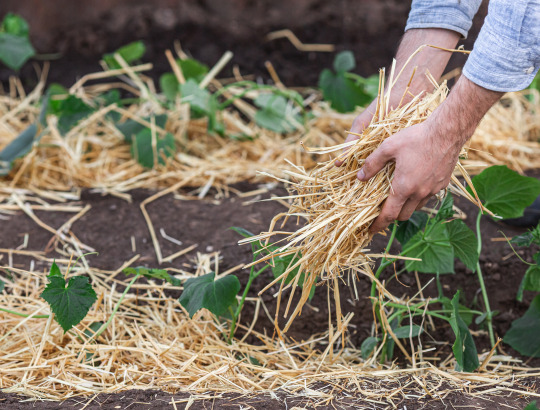
image source
The opposite approach, that is entirely foregoing the tilling of the soil, can have some positive results, provided you combine it with other techniques, such as mulching, sheet mulching, or even Hügelkultur beds, as I described in previous posts. Covering the soil with compostable material, or even non- compostable things, such as rocks, will reduce evaporation. Using ground cover and living mulch is again a contested topic, as "weeds" in general are seen as water parasites, who soak up and evaporate the water from our crops. However, no one may doubt the fact that under a short but thick layer of vegetation the ground is not only slightly more moist, but also cooler than where it is fully exposed to the baking sunlight. To fully appreciate this would be to stop looking at the plants in question as weeds, and start seeing them as a type of crop. After all, not only can we eat most weeds ourselves, but we can use clover for example as a rabbit pasture / cover crop.
The Right Plants in the Right Soil
The soil types with the best water retention are loamy, silty, as well as clay-rich soils. In fact, anything that is not in the sandy category is well suitable for dry farming. However, much more important for conserving moisture as well as nutrients, is the organic content of any soil. A good amount of humus can do wonders even to the worst sand pit. Again, this speaks for mulching and composting, which is useful everywhere, not just in arid climates.

image source
The next question is what to plant in the soil. It’s essential to pick drought resistant varieties that have been selected specifically for their genetic features to withstand longer periods without rain. The species most commonly mentioned are tomatoes, peppers, sunflowers, and of course the famous “three sisters”: corn, beans, and squash. Though there is a huge range of other potential dryland crops, for example melons, and potatoes. It’s a good idea to space the plants out more than you normally would, and case of fast and thick growth, they may be thinned out further. When it comes time to harvest, the chop-and-drop technique is a great way to keep the soil covered with the plants’ remaining organic matter, including the roots in the soil.
Dry Farming Doesn’t Mean Going Without Water
All living things need water, at least on this planet. This means, your garden or farm can’t grow a thing without being watered occasionally. So seasonal irrigation is still vital, especially to get your young plants established. For this reason it is essential to have your timing right, and take as much advantage of the rainy months as possible. Careful observation, and being on top of the changes in weather and climate helps greatly. Of course, nobody can anticipate the rains with complete exactitude, so it is still good to capture as much rainwater as possible, just in case you need to give your plants that little bit of extra watering, so they won’t die, but make it through the dry season bearing a plentiful harvest. All in all, however, if these dryland techniques are applied, the garden should be able to withstand droughts that could otherwise be seen as devastating.
Sources: 1, 2, 3, 4, 5, 6, 7, 8, 9
10 notes
·
View notes
Audio
Stop idolizing the grid and start idolizing Hügelkultur. BTX077
2 notes
·
View notes
Text
Making lists of what to sow next year!
The flower list in particular always changes and I end up getting more flowers than I meant to, but I tend to stick pretty well to the vegetable list.
Tryout for next year: corn.
And I'm building a new Hügelkultur this autumn.
2 notes
·
View notes